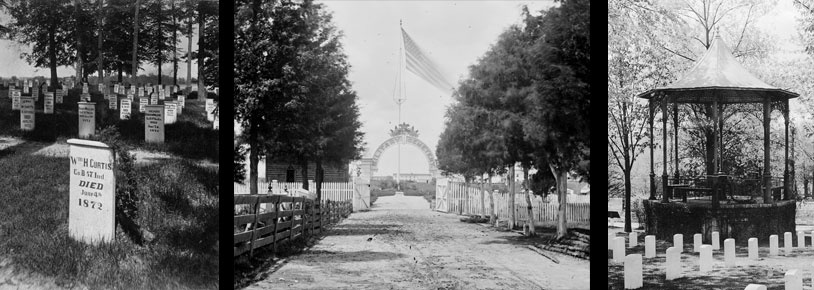

Civil War Era National Cemeteries: Honoring Those Who Served
Natchez National Cemetery
Natchez, Mississippi
 |
Natchez National Cemetery Postcard Courtesy of the Mississippi Department of Archives and History |
Natchez National Cemetery dates to 1866, one of 21 national cemeteries established in that year. Located on a bluff overlooking the Mississippi River, the site’s topography influenced its unique layout of irregular shaped burial sections, terraced hillsides, and gravel and grass pathways.
Natchez’s position on high bluffs above the Mississippi River contributed to its role as an important port and economic center. Both before and after the Civil War, cotton flowed through Natchez’s wharfs and docks, bound for destinations upriver and south to New Orleans. In May 1862, shortly after the Union capture of New Orleans and Baton Rouge, Natchez surrendered. Held by the Union for the duration of the war, the city escaped the damage and devastation seen by many other southern ports.
In 1866, the U.S. government purchased 11 acres for use as a national cemetery. The site chosen lay two miles north of the city center and adjacent to the Natchez City Cemetery, which dates to 1822. The site is irregular in shape—five uneven sides—and is enclosed by a brick wall built in 1873. Due to the steep topography, the cemetery features terraced burial sections of various shapes and sizes.
Original interments in the Natchez National Cemetery included Union soldiers who died while under care at a nearby military hospital. The U.S. government transferred remains of soldiers buried in and near Vidalia, Louisiana (across the Mississippi River from Natchez) and numerous other sites within a 50-mile radius of Natchez. By 1871, the cemetery held the remains of 3,086 Union men, with only 253 identified.
1893 Site Plan of Natchez National Cemetery. |
Two other cemetery structures were built in 1931; a brick and concrete maintenance building is located on the eastern edge of the cemetery, and the cemetery’s rostrum, used as a speaking platform, stands just north of the lodge.
Two Buffalo soldiers, members of the African American 24th U.S. Infantry regiments, are interred in the cemetery, as are members of the 58th U.S. Colored Infantry. Many of the burials in Section D of the cemetery are Union Navy personnel, who were reinterred from other burial places in the Natchez vicinity. The sailors served on some of the most decorated Union vessels, including Admiral David Farragut’s flagship USS Hartford and the river monitors Osage and Ozark.
Natchez National Cemetery is also the final resting place of a recipient of the Medal of Honor, the nation’s highest military decoration, given for “conspicuous gallantry and intrepidity at the risk of his life above and beyond the call of duty.”
| Plan your visit |
Natchez National Cemetery is located at 41 Cemetery Rd. in Natchez, MS. The cemetery is open for visitation daily from 8:00am to sunset. The administrative office is open Monday-Friday from 8:00am to 4:30pm; it is closed on all Federal holidays except for Memorial Day and Veterans Day. For more information please contact the cemetery office at 601-445-4981, or see the Department of Veterans Affairs website. While visiting, be mindful that our national cemeteries are hallowed ground. Be respectful to all of our nation’s fallen soldiers and their families. Additional cemetery policies may be posted on site. The Natchez National Historical Park is a National Park Service unit that shares Natchez’s history through two distinctive residences; Melrose, the antebellum plantation estate of John T. McMurran, and the downtown home of William Johnson, a free African American barber and diarist. Natchez National Cemetery was photographed to the standards established by the National Park Service’s Historic American Landscapes Survey. |
